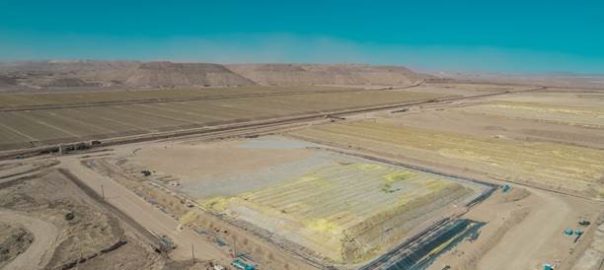The ability to leach primary copper sulphides has, on many occasions, proved a hurdle too much, with conceptual work in the laboratory or pilot scale falling down on sub-economic or volatile recovery rates when working out in the field.
This problem tends to result in one of two things: new capital-intensive concentrators are brought into process these sulphides, or brownfield oxide operations are drafted up that prolong existing leaching operations for a few more years when – hopefully – copper prices are higher.
Antofagasta has come up with an alternative option that leverages chloride-based reagents and 20-years of knowledge leaching secondary sulphides.
Called Cuprochlor®-T, the proprietary process has undergone five years of intense development leading to the point that the company is now open to talking about its potential.
It leverages off the first iteration of leaching technology Antofagasta devised for secondary sulphides – Cuprochlor.
Cuprochlor, which is now working at the Michilla mine in Chile (which Antofagasta sold in 2016), effectively binds together the particles of mineral – particularly fine in the case of Michilla – into a porous but manageable material that can then be heap leached. The agglomeration is achieved by mixing the mineral and leach solution with chloride salts and sulphuric acid, which react to form a plaster-like paste.
Over the years, the process has been refined, going on to consistently deliver recovery rates of around 90%.
Sitting on an expansive base of primary sulphide resources – mainly chalcopyrite – and the success of Cuprochlor, Antofagasta, around five years ago, began a series of tests, adjusting variables such as temperature, reagent concentrations and particle size to see if the chloride leaching process could be adapted for the treatment of primary sulphides.
Temperature proved to be one of the keys, with tests showing that by elevating the temperature of the heap to around 30°C, Cuprochlor-T was able to stimulate the required chemical reaction for recovering copper from primary sulphides such as chalcopyrite.
Another key differentiator between the two chloride leaching technologies is the “reagent recipe” and particle size distribution (PSD), Alan Muchnik, VP Strategy & Innovation for Antofagasta, told IM.
“Providing a constant temperature throughout the process is very important, but the real innovation is the approach we have used,” he said. “It involves a combination of factors, including, among others, the recipe for reagent concentrations and the required PSD.”
While not wanting to reveal the ‘secret sauce’, Muchnik said the PSD consideration goes beyond the usual P80 industry reference point.
It is this balance that has landed the company with recoveries of over 70% after approximately 200 days of leaching on the heap in test work.
Muchnik expanded on this: “The Cuprochlor-T process, in simple terms, involves leaching in a chloride environment – where there are no passivation layer bonds. This allows for the copper, iron and chloride ions to react, which, at a controlled temperature, results in the economic production of copper.”
This is through three stages:
- First up is an agglomeration stage where the necessary reagents are added and are left to rest at a constant aeration and temperature;
- Second, the ore is irrigated intermittently with continued aeration, also maintained at a constant temperature; and
- Finally, after 200 days, the ore completes the leaching cycle and allows the company to obtain recoveries of 70% copper or more.
What started with laboratory testing and progressed to pilot testing and a “semi-industrial” test on several different heaps at Centinela has recently concluded with an industrial test of over 40,000 t of primary sulphide material averaging 0.4% Cu – containing more than 90% chalcopyrite – that, using the same process outlined by Muchnik, showed consistent recoveries of over 70%, he said.

Asked if the company is eyeing even higher recoveries that can compete with the levels Cuprochlor is achieving on secondary sulphides, Muchnik said it was all about an economic tradeoff.
“It may be possible to hit such a percentage [as Cuprochlor], but that is not the aim or expectation with the kinetics we are currently seeing in Cuprochlor-T,” he said. “There is always a tradeoff between the length of irrigation time, the PSD and the recoveries, all of which are related to capital costs, operating costs and the payback associated with the process.”
The Antofagasta planning and operations teams have now got their hands on the Cuprochlor-T ‘licence’ and will be busy outlining potential deployments for consideration in the company’s annual planning cycles.
There are some obvious places to start.
The Zaldívar open-pit, heap-leach copper mine, 175 km southeast of Antofagasta, is currently in the process of transitioning to chloride leaching operations with Cuprochlor.
The project, which includes an upgrade of the SX plant and the construction of new reagent facilities and additional washing ponds for controlling chlorine levels, was completed in January 2022 and is now being commissioned. It is set to boost copper recoveries by approximately 10 percentage points, increasing production at Zaldívar by around 10,000–15,000 t/y over the remaining life of mine.
“In addition to transitioning to chloride leaching with Cuprochlor for secondary sulphides, we are currently progressing studies for the primary sulphide orebody that currently lies below the Zaldívar reserves to prove if Cuprochlor-T leaching can work,” Muchnik said. “Within our resource base, there are approximately 460 Mt of primary sulphide resources declared here.”
Both Centinela and Antucoya have primary sulphide resources and existing heap leach and SX-EW facilities that would fit the Cuprochlor-T blueprint too.
Muchnik said: “One of the technology attractions of Cuprochlor-T is the ability to use otherwise idle leach pad and SX-EW capacity. That it is the scale limitation at our current operations, but the technology can be gradually deployed within a plant that is already adapted for chloride leaching, phasing this in during the life of mine to fit requirements.
“It provides an ongoing adoption process option rather than an immediate infrastructure project that sees an operation shift from oxide leaching to a different kind of heap leaching in one go.”
The advent of Cuprochlor-T does not mean the company will completely drop potential concentration projects, Muchnik clarified, highlighting the second concentrator project currently subject to a feasibility study at Centinela.
In addition to the capital and operating cost benefits that would come with Cuprochlor-T over the concentration route, there is likely to be a sustainability benefit.
“It’s only an indicative reference as each case is different, but you would expect the energy consumption associated with Cuprochlor-T leaching and SX-EW treatment to be less than half of the normal route of copper concentration and SX-EW,” Muchnik said.
In this respect, it is a favourable consideration for Antofagasta’s long-term carbon-neutral goals.
While each potential Cuprochlor-T implementation will have to go through corresponding project studies, Muchnik was confident in predicting that new copper from Cuprochlor-T would be produced this decade.
With five years of substantial testing under its belt, not many metallurgists would bet against him.







